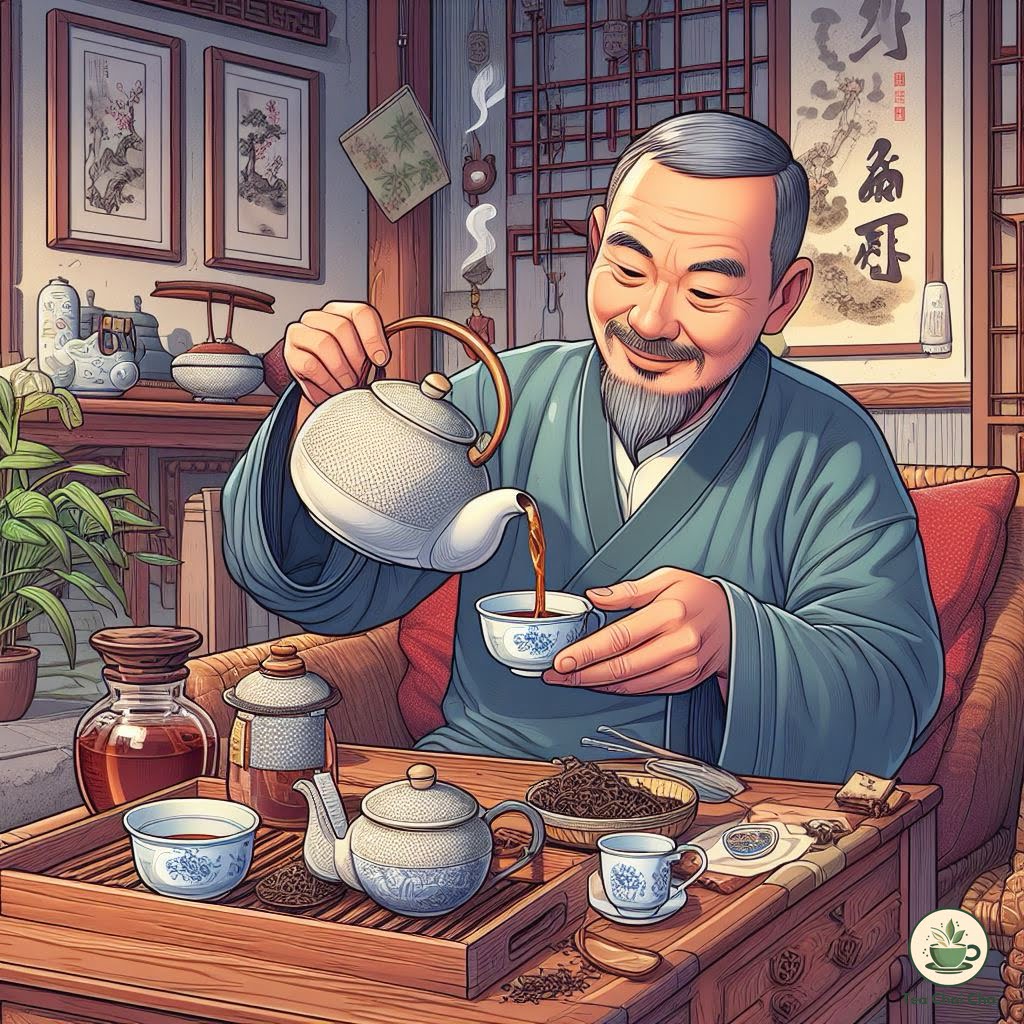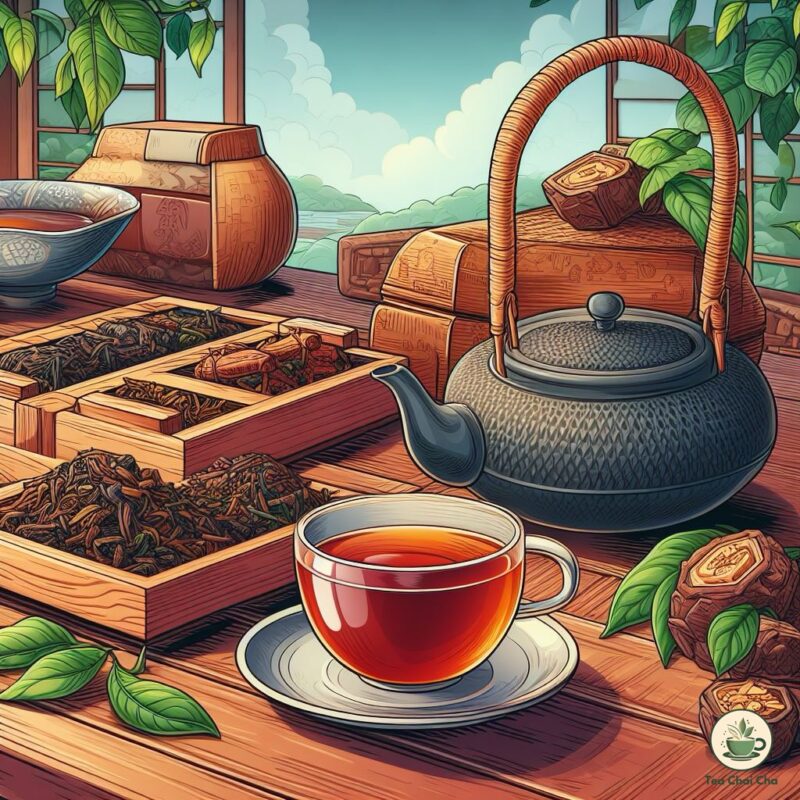Exploring Pu-erh tea and wanting to make the perfect cup from the get-go?
You’ve got two paths: the traditional Chinese way, steeped in culture, or the modern Western method for simplicity.
Your choice depends on the experience you seek.
With this guide, perfect your tea brewing technique, ensuring a delightful cup every time.

What Is Pu-erh Tea?
Pu-erh tea is a distinctive fermented tea hailing from Yunnan, China.
It comes in two forms – sheng (raw) and shou (ripe), and is often compressed into cakes or bricks, giving it a unique appearance.
This tea stands out for its bold, earthy flavor, making it a favorite among tea enthusiasts worldwide.
Its fame arises from the intriguing post-fermentation process, which imparts a dark and robust character, as well as the potential health benefits it offers.

How to Make Pu-erh Tea – Traditional and Modern Methods
To make traditional Chinese Pu-erh tea, you will need Pu-erh tea leaves, typically about 2-3 grams per 6 ounces of water.
It’s essential to use high-quality Pu-erh leaves for an authentic taste.
Tools for Traditional Chinese Pu-erh Tea
- Teapot: A small, unglazed clay teapot is traditionally used for brewing Pu-erh tea. Its porous nature enhances the tea’s flavor.
- Tea Tray: A dedicated tea tray is helpful to catch any spilled water during the brewing process.
- Tea Cups: Small, unglazed tea cups are used to serve Pu-erh tea. They should match the teapot for uniformity.
Instructions for Traditional Chinese Pu-erh Tea
- Rinse the Teapot: Pour boiling water into the teapot, swirl it around, and pour it out. This warms the teapot and removes any impurities.
- Warm the Cups: Pour boiling water into the tea cups to warm them, then pour it out.
- Measure the Tea: Place the desired amount of Pu-erh tea leaves into the teapot.
- First Infusion: Pour boiling water (about 212°F or 100°C) into the teapot and let it steep for about 10-20 seconds. Pour off this infusion. This is the first infusion, known as the “wash,” meant to awaken the tea leaves.
- Subsequent Infusions: Pour boiling water into the teapot for subsequent infusions, allowing the tea to steep for a bit longer with each infusion. Start with 30 seconds for the second infusion and increase the steeping time by 10-15 seconds for each subsequent infusion. You can get 4-8 infusions.
- Serve: Pour the tea into the warmed tea cups, savoring the rich flavors and aroma of Pu-erh tea.

Tools for Western Method Pu-erh Tea
- Teapot or Teacup: You can use a regular teapot or a teacup to brew Pu-erh tea in the Western method. Make sure it has a lid to cover the tea while steeping.
- Boiling Water Source: A kettle or a pot to heat water to boiling point, typically around 212°F (100°C).
- Mug or Teacup: A mug or teacup to serve your brewed Pu-erh tea.
- Tea Strainer (Optional): If you prefer not to have tea leaves in your cup, you can use a tea strainer to pour the tea through when serving.
Instructions for Western Style Pu-erh Tea
The Western method of brewing Pu-erh tea is indeed different from the traditional Chinese approach and is known for creating a stronger and bolder brew.
Here’s how to do it:
- Measure the Tea: Use 2-3 grams of Pu-erh tea leaves for every 6 ounces (180 ml) of water. This maintains the same tea-to-water ratio as the traditional method.
- Boiling Water: Heat the water to boiling point, around 212°F (100°C), just as in the traditional method.
- Steeping Time: Pour the boiling water over the Pu-erh tea leaves in a teapot or teacup. For the Western method, you can steep the tea for a longer duration, starting with 5 minutes.
- Adjust to Taste: The remarkable feature of the Western method is that you can steep Pu-erh tea almost indefinitely. If you prefer a stronger brew, you can increase the steeping time in subsequent infusions to your liking, such as 10 minutes, 20 minutes, or even 50 minutes. As Pu-erh tea steeps longer, it becomes fuller and stronger, but it won’t turn bitter, acidic, or astringent. Some might find it sweeter as well.
- Serve: Once the tea reaches your desired strength, you can pour it into your teacup or mug. Enjoy the bold, full-bodied flavors of your Pu-erh tea.

Pu-erh Tea with Milk – How to Brew It
Although pu-erh tea tastes amazing on its own, you can add milk in it to mellow the taste.
This distinct combination of robust Pu-erh tea and creamy milk offers a rich and flavorful beverage.
To make it, you’ll need a few simple ingredients, tools.
Ingredients
For making Pu-erh tea with milk, you will require the following:
- 1 teaspoon of loose-leaf Pu-erh tea.
- 1 cup (8 ounces) of water.
- 1/4 cup of milk (whole or any plant-based milk of your choice).
- Optional: Sweetener like sugar or honey, to taste.
Tools
To prepare this tea, you’ll need:
- A teapot or infuser.
- A stove or kettle for heating water.
- A saucepan or microwave-safe container to heat the milk.
- A strainer or fine mesh filter.
Instructions
- Begin by heating the water in a kettle or on the stove until it reaches a gentle boil.
- Place the loose-leaf Pu-erh tea in the teapot or infuser.
- Pour the hot water (about 8 ounces) over the tea leaves and let it steep for 3-5 minutes. Adjust the steeping time based on your taste preferences.
- While the tea is steeping, heat the milk in a saucepan or microwave until it’s hot but not boiling.
- After the tea has steeped, strain it into a cup.
- Pour the hot milk into the cup with the tea.
- Optionally, sweeten with sugar or honey to taste.
- Stir well and enjoy your Pu-erh tea with milk.

How to Make Cold Brew Pu-erh Tea
If you want to enjoy iced pu-erh tea, cold brew is the most forgiving method to make it.
And if you want the best taste of pu-erh tea, use raw pu-erh as it is not fermented for so long and lacks bacteria and fungi.
Ingredients
For a single serving, you’ll require about 2 tablespoons of raw pu-erh tea leaves and approximately 16 ounces (500 ml) of cold, filtered water.
You can adjust these quantities based on your preference for tea strength.
Tools
You’ll need a glass container or pitcher with a lid, a fine mesh strainer, and optionally, some ice cubes for a chilled result.
Instructions
- Measuring the Tea: Start by measuring out approximately 2 tablespoons of raw pu-erh tea leaves. Adjust the amount to your taste, but this is a good starting point.
- Add Cold Water: Place the measured tea leaves in a glass container or pitcher. Now, pour about 16 ounces (500 ml) of cold, filtered water over the tea leaves. You can use room temperature or cold water, depending on how quickly you want to enjoy your tea.
- Stir and Seal: Give it a gentle stir to ensure the tea leaves are evenly soaked. Then, seal the container with a lid or cover it with plastic wrap.
- Refrigerate: Place the container in the refrigerator and let it steep for a minimum of 8 hours, or overnight. This slow steeping process brings out the unique flavors of the raw pu-erh tea.
- Strain: After the steeping time is up, take the container out of the refrigerator and use a fine mesh strainer to filter the tea into a new glass. This will remove the tea leaves and any fine particles, leaving you with a smooth cold brew.
- Serve and Enjoy: You can enjoy your cold brew pu-erh tea as is, or if you prefer it extra cold, add some ice cubes. Feel free to sweeten it to your liking with sugar or honey.
5 Types of Pu-erh
If you’re delving into the world of Pu-erh tea, it’s essential to understand the two key types available: raw pu-erh and ripe pu-erh.
Let’s break down the distinct characteristics of each type for your convenience.
1. Young Raw Pu-erh (Sheng Cha)
When you encounter young raw Pu-erh, you’ll notice its vibrant, greenish leaves.
This tea is a raw, unprocessed gem, and it boasts a fresh and somewhat astringent flavor.
Expect a brisk, grassy taste with a touch of bitterness.
It’s the choice of those who appreciate the vitality of youth in their tea.
2. Aged Raw Pu-erh
As raw Pu-erh ages, it transforms.
The leaves darken, and the flavor becomes smoother.
The astringency mellows, and you’ll discover complex earthy and floral notes.
Aged raw Pu-erh is for those who seek a more refined, mature tea experience.
3. Ripe Pu-erh (Shu Cha)
This tea has a dark appearance, thanks to a post-fermentation process.
Ripe Pu-erh offers a smooth, mellow character with a hint of sweetness.
Its flavor is typically earthy, woody, and less astringent.
That’s why it’s an excellent choice for those new to Pu-erh or those who prefer a gentle, accessible tea.
4. Aged Ripe Pu-erh
Just like aged raw Pu-erh, aged ripe Pu-erh undergoes a maturation process.
This aging deepens its flavor, enhancing its complexity.
The result is an even smoother, richer, and more nuanced tea.
Aged ripe Pu-erh is a favorite among connoisseurs who appreciate the depth it brings to their cup.
5. Flavored Pu-erh (Usually Just Ripe)
Flavored Pu-erh is a creative take on the Pu-erh experience.
Typically based on ripe Pu-erh, it’s infused with natural ingredients, such as fruits, flowers, and herbs, adding exciting new flavors and aromas.
While the tea’s core character remains ripe, the added elements provide a delightful twist.
It is a unique and intriguing choice for those who enjoy variety in their tea collection.

How to Make Pu-erh Tea Taste Better
Here I have some tried and tested tips to make your pu-erh tea taste much better, in case you don’t like its natural taste.
-> Enhance with Dry Fruits
Boost the flavor of your Pu-erh tea by adding dried fruits like apricots, cherries, or figs.
Simply drop a small quantity of your chosen dried fruit into the tea while it’s steeping.
The sweetness and fruity notes from the dried fruits can infuse your tea with delightful flavors.
-> Sweeten It Right
If you prefer a sweeter taste, you can sweeten your Pu-erh tea with natural sweeteners like honey or agave syrup.
Add a teaspoon of your preferred sweetener to your tea and adjust to taste.
Keep in mind that Pu-erh tea is naturally earthy, so a little sweetness can go a long way.
-> Citrus Zest and Spices
Experiment with citrus zest or spices to give your Pu-erh tea a zesty twist.
A small strip of orange or lemon zest can add a refreshing citrus note, while a pinch of spices like cinnamon or cardamom can create a warming, aromatic blend.
-> Milk or Cream
For a creamy and indulgent Pu-erh tea, consider adding a splash of milk, condensed milk, or cream.
This can mellow out the tea’s strong flavors and create a comforting, latte-like experience.
Adjust the amount of milk or cream to achieve your desired level of creaminess.
-> Herbal Infusions
Combine Pu-erh with herbal infusions like mint, lavender, or chamomile to introduce unique flavor profiles.
These herbs can complement the earthiness of Pu-erh and provide a refreshing twist.
-> Choosing Quality Pu-erh Tea
Start by selecting high-quality Pu-erh tea leaves.
Opt for well-stored, loose-leaf Pu-erh or Pu-erh cakes from reputable sources.
The better the quality of the tea, the more potential it has to taste delicious.
-> Proper Storage Matters
Ensure that your Pu-erh tea is stored correctly.
Keep it away from strong odors and in a cool, dry place.
Proper storage helps maintain the tea’s flavors and prevents it from absorbing unwanted scents.
-> Temperature and Water Quality
Use fresh, clean water and bring it to the right temperature.
For Pu-erh tea, water that’s around 212°F (100°C) works well.
Avoid using water that’s too hot, as it can make the tea taste bitter.
-> Rinsing the Pu-erh Leaves
Before brewing, give your Pu-erh tea leaves a quick rinse.
Pour hot water over the leaves, then discard this water.
This step helps remove any impurities and primes the leaves for brewing.
-> Steeping Time and Amount
Pay attention to the steeping time and the amount of tea you use.
Typically, 1 teaspoon of tea leaves per 8 ounces of water is a good starting point.
Steep the pu-erh tea for around 3-5 minutes.
Adjust the time and tea amount to your taste preferences.
-> Mind the Brewing Vessel
The vessel you use for brewing makes a difference.
Clay teapots or Yixing pots are excellent choices for Pu-erh tea as they can enhance its flavor.
They gradually absorb the tea’s aroma, contributing to a more enjoyable taste over time.
Pu-erh Tea Food Pairing
When it comes to savoring Pu-erh tea, you can enhance your experience by pairing it with the right dishes.
Whether you’re looking for savory or sweet options, here are some delectable choices for your next tea session.

Savory Pairings
- Dim Sum: The richness of Pu-erh tea complements the various flavors and textures of dim sum, such as dumplings, spring rolls, and buns. It’s an ideal pairing for a satisfying meal.
- Sushi: The earthy notes of Pu-erh tea harmonize with the delicate flavors of sushi, making it an excellent choice for those who enjoy Japanese cuisine. Sip your tea in between bites for a delightful contrast.
- Aged Cheese: Pairing Pu-erh with aged cheeses like cheddar, gouda, or parmesan brings out the complex undertones of the tea. The creamy, nutty flavors of the cheese blend well with the tea’s depth.
- Roasted Meats: Whether it’s roasted duck, lamb, or pork, Pu-erh tea can cut through the richness and offer a balanced contrast, making your meal even more satisfying.

Sweet Pairings
- Dark Chocolate: The bitterness of dark chocolate complements the earthy and slightly smoky notes of Pu-erh tea. The combination is a match made in heaven for dessert lovers.
- Honey Cakes: The sweetness of honey cakes balances the robust flavors of Pu-erh tea. The subtle floral undertones of the tea play well with the honey’s sweetness.
- Citrus Desserts: Lemon bars, orange zest cake, or grapefruit tarts can provide a refreshing contrast to the tea’s earthy profile. The citrusy zing pairs wonderfully with Pu-erh.
- Almond Biscotti: The nutty aroma of almond biscotti enhances the tea’s nutty notes, creating a delightful harmony for a sweet treat.

When to Drink Pu-erh Tea
Timing is crucial when deciding when to drink Pu-erh tea.
Morning is a popular choice, as it can provide a gentle caffeine boost to kickstart your day.
Pu-erh tea contains less caffeine than coffee but more than most herbal teas, making it a moderate choice for morning consumption.
Afternoon is another suitable time for Pu-erh tea.
It can offer a milder pick-me-up compared to morning, helping to combat that mid-afternoon slump.
The caffeine content can provide a mild energy boost without interfering with your sleep if you plan to retire for the day in the evening.
While you can drink Pu-erh tea in the evening, be mindful of the caffeine content.
Consuming it too late might affect your ability to fall asleep.
But some people find that Pu-erh tea’s soothing and digestive qualities make it a good post-dinner choice.

Related Guides on Tea Making
Pu-erh Tea Recipe
Recipe by Tania FaysalCourse: DrinksCuisine: Chinese2
servings4
minutes5
minutes5
kcal9
minutesDelight in the rich, earthy flavors of the traditional Pu-erh tea, serves 2.
Ingredients
2 teaspoons of Pu-erh tea leaves
4 cups of filtered water
Optional: Honey or brown sugar to taste
Directions
- Prepare the tea pot: Clean your teapot thoroughly to ensure there are no leftover flavors that could impact your tea.
- Boil the water: Bring 4 cups of filtered water to a boil in a kettle or saucepan.
- Add the tea leaves: Once your water reaches a rolling boil, reduce heat to low and add 2 teaspoons of Pu-erh tea leaves.
- Steep the tea: Allow the tea to steep at around 212°F (100°C) for 5-7 minutes, depending on your taste preference. The longer the tea steeps, the stronger the flavor.
- Strain and serve: Strain the tea into cups, add honey or brown sugar to taste, and enjoy the rich, earthy flavors of Pu-erh tea.
Recipe Video
Notes
- You can use 3 grams or 1 teaspoon of pu-erh tea if you have pu-erh brick.
- This is the modern method but you can brew your pu-erh tea using Gongfu method as well.
- If you want to mellow its taste, add a splash of milk or condensed milk. If you want to make it fruity, add dried fruits while brewing.
Frequently Asked Questions (FAQs)
What does Pu-erh tea taste like?
Pu-erh tea tastes earthy and robust, often described as having a deep, rich flavor with subtle earthy and woody notes.
Does Pu-erh tea have caffeine?
Yes, Pu-erh tea contains 30-100 mg caffeine per 8 oz. cup. It is a type of fermented tea, which retains caffeine, though the content may vary.
Is Pu-erh a real tea?
Pu-erh is indeed a real tea from Camellia sinsensis plant, specifically a type of fermented tea originating from Yunnan, China.
How many calories are in Pu-erh tea?
Pu-erh tea typically contains very few calories, approximately 2-5 calories per 8-ounce cup.
How much pu-erh tea to use?
Use about 1 teaspoon or 3 grams of Pu-erh tea per 8-ounce cup of water. Adjust to taste.
How long to brew pu-erh tea?
Brew Pu-erh tea for 3-5 minutes in water just below boiling temperature, around 205-212°F (96-100°C).
How to rinse pu-erh tea?
To rinse Pu-erh tea, pour boiling water over the leaves and immediately discard the water. This helps remove any impurities and awaken the tea leaves.
When did you first tried pu-erh tea? How your experience? Let me know in the comments below!


